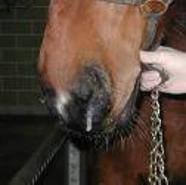Equine herpes virus (EHV) type 1 infections have recently been confirmed in the surrounding Chicago-land area and surrounding Midwest areas. With the 2015 show season almost in full swing, we would like to provide you with accurate information on herd prevention and monitoring. Equine herpes viruses have been present in the equestrian population all over the world for many, many years. There are many different strains of the virus and most are not a problem for individual horses. This emerging form of the virus, EHV type 1, has developed a specific genetic mutation which is more likely to cause neurologic signs in horses that are infected by it. Like any of the herpes viruses, individual horses can carry the virus without showing any signs of sickness. During periods of stress, they can begin shedding the virus and transmit to other horses that it comes into contact with.
Unfortunately, there is no vaccine that is available for the equine herpes virus-1 neurologic form. However, routine vaccination with the available EHV vaccines has shown to provide some cross protection and can decrease severity of the neurologic form of the infection. We currently recommend that any horses traveling or housed with horses that are traveling, be vaccinated every 6 months.
 The virus is primarily spread from horse to horse by coughing or sneezing. However, the virus can also be transmitted by contaminated tack, equipment, feed and water buckets or by people carrying the virus between horses. It is imperative to first clean and then disinfect all routes of possible transmission. The virus is killed by most disinfectants. Use hand sanitizer after touching a house or when moving between horses. Keep horses from mingling close together. Use bleach water (1 part bleach: 10 parts water) to disinfect equipment.
The virus is primarily spread from horse to horse by coughing or sneezing. However, the virus can also be transmitted by contaminated tack, equipment, feed and water buckets or by people carrying the virus between horses. It is imperative to first clean and then disinfect all routes of possible transmission. The virus is killed by most disinfectants. Use hand sanitizer after touching a house or when moving between horses. Keep horses from mingling close together. Use bleach water (1 part bleach: 10 parts water) to disinfect equipment.
 After infection, signs can develop as quickly as 24 hours but can be longer than 6 days. Signs to watch for include lethargy, nasal discharge, loss of appetite, persistent cough and fever. Neurologic signs include incoordination that can progress to inability to stand, urine dribbling, lower limb swelling, loss of tail tone, inability to urinate or defecate.
After infection, signs can develop as quickly as 24 hours but can be longer than 6 days. Signs to watch for include lethargy, nasal discharge, loss of appetite, persistent cough and fever. Neurologic signs include incoordination that can progress to inability to stand, urine dribbling, lower limb swelling, loss of tail tone, inability to urinate or defecate.
 In an effort to actively monitor your horse, we recommend daily temperature monitoring; taken before, during and 10 days following a show. Keep new horses or horses returning to the barn, isolated from other horses. If your horse’s temperature is greater than 101.5 degrees, any respiratory signs are observed or any of the other signs previously described, we ask that you call us immediately for an examination.
In an effort to actively monitor your horse, we recommend daily temperature monitoring; taken before, during and 10 days following a show. Keep new horses or horses returning to the barn, isolated from other horses. If your horse’s temperature is greater than 101.5 degrees, any respiratory signs are observed or any of the other signs previously described, we ask that you call us immediately for an examination.
So as you go through the 2015 show season it is important to understand basic biosecurity in order to protect the health of your horse and the horse next to your horse. Taking your horse to a show will never be a NO RISK situation, but we can take these steps to greatly decrease risk associated with disease transmission. Please feel free to contact us if you have any questions regarding Equine Herpes Virus or the health of your horse. 888-860-0244

